I inherited a bunch of vintage patterns from my Grandmother, and more from an honourary aunt, plus I’ve bought plenty, and been given even more by other lovely people, over the years.
I estimate that my collecting is nearly 1,000 pattern dating from the mid 1920s, to the 1980s (plus there are the modern patterns I own!)
So how do I store and care for all of these patterns?
There are lots of posts entitled “How to store and organise patterns,” but really, there is no one right answer. This is just how I do it.
First, each pattern goes in its own, individual, zip-lock bag. I pay $14 per 100 bags in just the right size (and try not to think about the fact that I’ve spent almost $150 in storage!).
The bags protect the patterns, and keep the envelopes, some of which are fragile or torn, or coming apart at the seams where the glue has failed, from further damage.
I’m working on transferring the collection to acid free comic book bags, because the bags can off gas on to the patterns.
I can also tuck notes about the pattern in the envelope: when and where I acquired it, when I’ve made it up, and what I’ve made it in, plus any alterations I’ve made to it. I can even put scraps of the fabric I used in the bag! They become their own little mini time-capsules, without writing on or altering the pattern.
The one drawback to storing the patterns in comic book envelopes is the size. Every time I make up a vintage pattern I transfer all the pattern pieces to patterning fabric (amazing stuff – doesn’t fray, can be pressed). The patterning fabric pattern fits nicely in a ziplock bag with the original pattern, but it too bulky for the comic book envelopes. I love that the fabric means I can tell at a glance if I’ve made it, and can make it again and again without damaging it.
Here are the pattern pieces for Butterick 6223 (in the top corner) which I made up as the Aloha Ka Manini blouse (which reminds me that I’ve stopped doing song associations for each sewing project, and I really should revive that tradition!)
The patterns then all go in a rather motley collection of boxes – some beautiful, some plain old cardboard, as long as they are the right size to place the patterns in them without squashing them.
There are lots of theories and discussions on how you should sort your patterns. Many people advocate sorting by pattern company, and number. That doesn’t work for me – it’s not how I think of patterns, and it’s not how I remember them, and it’s certainly not how I look for them. It might work if I had all my patterns photographed and catalogued and cross-referenced by type ready to be looked up at a moment’s notice (but let’s be realistic, unless someone buys me a winning lottery ticket big enough that it would allow me to have a PA, that just isn’t going to happen).
Instead of using company and number, I sort my patterns by decades, and types of patterns. For example, I have a box of 1950’s dress patterns, a box of 1950’s separates patterns, a box of 1950’s coats and outerwear patterns, and a box of 1950’s accessories (hats and aprons etc) patterns. When I am looking for a pattern I usually think to myself “I’d really like to make a 1960’s coat with this” or “This fabric is perfect for the 1930s” or “I know I’ve seen that shape in a lot of ’50’s bodices.”
So sorting by decade and pattern type just makes more sense for how I work with patterns.
At the moment, I also have my patterns sorted by provenance: a box of 1950s dresses from my Grandmother, and another one of boughten ones, a box of 1960s dresses from an honourary aunt, and another from a friend, etc. etc. I’m slowly putting labels and acquisition information in every pattern bag, so that I can have all of my 1960s dresses in one place (instead of divided in four different boxes by source). It’s a little obsessive, but provenance is so important from a historian’s perspective, and the stories are half the joy of the pattern.
The other half of the joy, of course, is how gosh darn beautiful they are, and how fun they are to sew with!

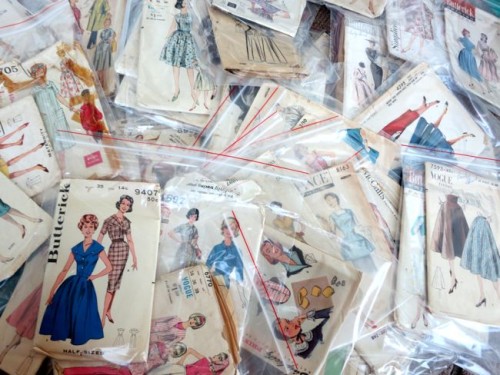
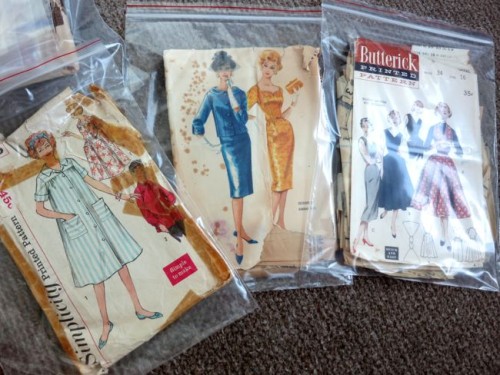
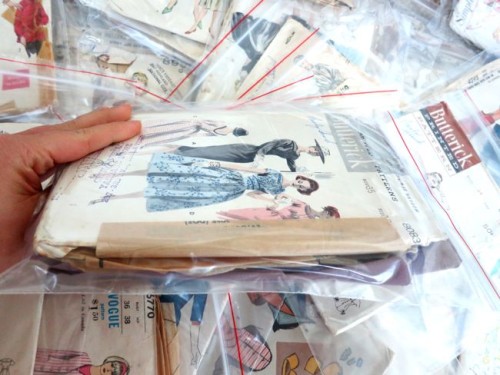
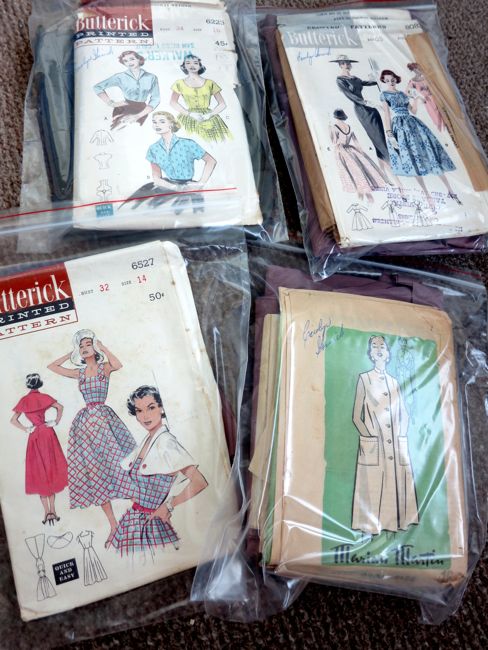

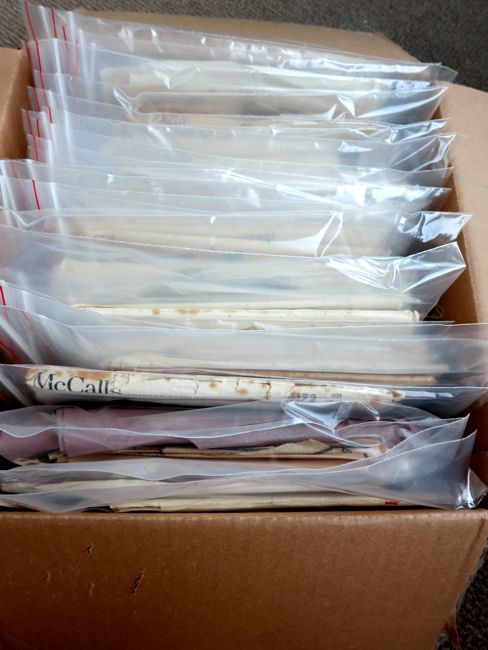
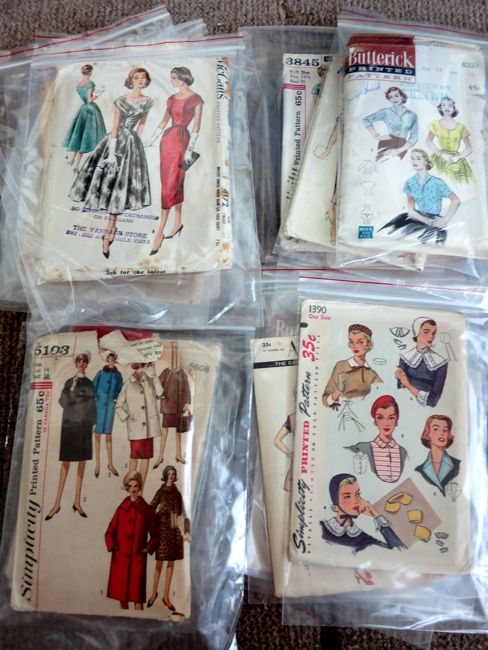

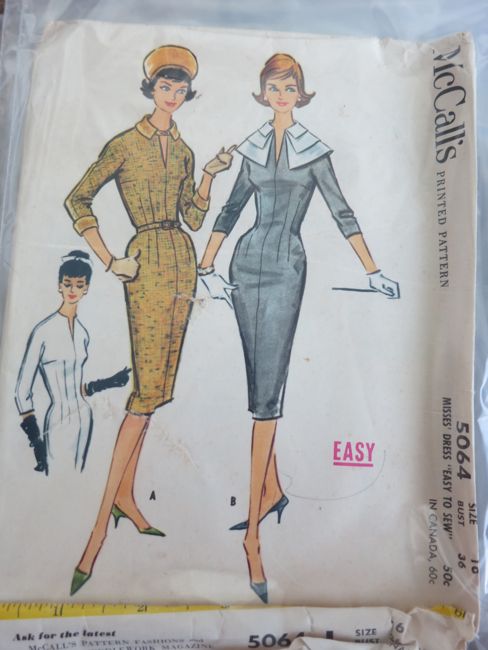
Wow, so many patterns – they look like an amazing collection.
I’ve occasionally seen sellers mention archival quality bags for vintage patterns – is there such a thing, or are all plastic bags basically equivalent?
You have a awesome collection it looks like! I don’t know about others but I sure would be interested in seeing each one. 🙂 Maybe like a weekly or monthly sharing of a few.
Wow. I am drooling here! O_O
Neat idea for pattern storage! I use plastic folders or ‘letter files’ – just A4 plastic envelopes which can carry the same amount of stuff as yours do. I trace the pattern and put it back in its envelope. If Im good, I scan and print the instructions and envelope too.
Because the scanner isnt plugged in at the mo, Ive been too lazy to do all that. AND I have your blouse pattern traced and ready – just have to scan the envelope – sorry for the delay! I should get to it!
Love your collection! I find storing (any) patterns is such a pain. I need to come up with a good solid system and I like your ziplock bag method. 😀
-Rebecca
mn2nz.wordpress.com
I use comic book sleeves – big enough to fit the largest pattern in and because they’re for comic collectoring, acid free.
I was just going to suggest comic book storage as well! You can even ‘bag and board’ them as geeks say, so not only are they protected by the bag but the board should help protect them from damaged (bending etc) as well. And then you can store them in comic boxes.
I only own a few vintage patterns and I keep meaning to bag and board them, just haven’t gotten around to it yet…
Hey, I have Butterick 9407 (in your 1st photo) too!
I really need to get on with bagging all my vintage patterns – thanks for reminding me I need to get serious about this!
Implementing a proper storage and organization system for my vintage patterns is something I’ve been working on bit by bit for some years now. I had initially organized them by type, but have been gradually moving over to more of a catalogue system. It’s taking a long time, especially since I only work on it sporadically, but it’s pretty easy. I decided to scan the fronts and backs of each pattern on my home printer, copy & paste them into word documents to print the front and back together onto 1 page and put them into a binder organized by garment type. Once I’ve done that for a pattern, it then gets stored purely by number to make it super easy to find. This also serves one of my conservation-training concerns: handling. By having images of both the front & back of the pattern I can both look at the style and determine fabric requirements without having to handle the actual pattern. Although having them all properly bagged would help with this a lot and should probably be my more pressing concern. :o/
I use Pinterest as a visual pattern catalogue. I can open my board and see all the patterns I own in one place. I can usually find an image of the pattern on Pinterest or google to pin from, then I don’t have to take pictures or scan. I just put the size in the information box and I’m set.
It looks like you have a lovely collection!
Thank you for the post, this is right up my OCD alley! I’ve never counted my patterns but they would be in the 100s from 1930s through to now. At the moment all my vintage patterns are in white A4 paper envelopes with a copy of the original pattern envelope picture pasted on the outside. The envelope is then big enough to store the traced pattern (I LOVE patterning fabric, so much easier than tracing paper to use), any notes and swatches. Patterns from the 80s to now I do the white envelope thing as I use and trace them. After many years of sheer laziness I have now got into the habit of tracing patterns, as I appreciate those vintage ones that have been traced, and the modern ones will be vintage one day. I do have difficulty finding boxes to store the patterns in, at the moment it is a motley collection of “almost the right size” plastic tubs and cardboard boxes. I do like Jennilee’s comic book storage idea…..
I use cellophane (?) bags to protect pattern envelopes; the type that expensive birthday cards etc are packaged in for protection. They are cheap to buy in bulk, and come in a variety of sizes. I use smaller ones to store fragile trims, plus beads, buttons etc; that way you can always see what’s inside. Also makes storage easier as everything’s a similar size.
As the girls there said- comic storage is a great suggestion! Your patterns collection is really fascinated! Thank you for sharing it with us!